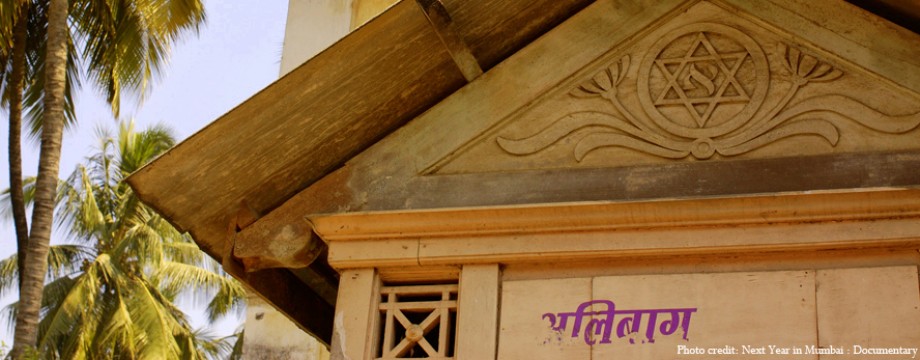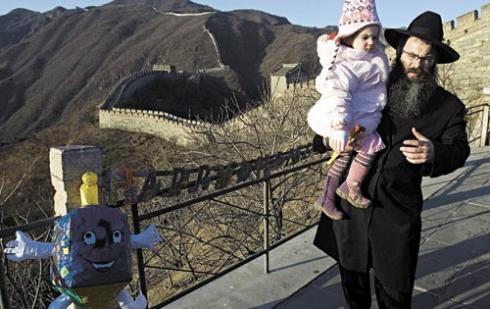Chabad’s Rabbi Shimon Freundlich marks Chanucah at the Great Wall of China near Beijing
Erica Lyons runs Asia’s brand-new Jewish magazine, Asian Jewish Life, from a small office in central Hong Kong. It is the region’s “Jewish cultural headquarters”, she jokes with her office mate, a journalist who presides over Hong Kong’s Jewish Film Festival.
But while they may poke fun at their fledgling project, the magazine’s launch this January is a symptom of real change in Asian Jewry. Whereas far-flung communities in places like India and China are often regarded as exotic relics of the past, Jewish life in the region is undergoing a renaissance.
The American Jewish Yearbook shows that there was a total of about 1,000 Jews in Hong Kong and China in the mid 1990s, and another 1,000 in Japan. Today, there are perhaps 5,000 in Hong Kong alone, with another 2,000 in Shanghai.
Like the Baghdadi Jews who fanned out across Asia and India hundreds of years ago, today’s Jews are lured to the region primarily by business.
“Shanghai and Beijing have a lot more Jews than five or 10 years ago,” said Philip Jay, editor of Jewish Times Asia, an established monthly tabloid.
While the overall growth is hard to quantify, in part because of the transient nature of expatriate lifestyles, communities of between 500-1,500 people exist in Tokyo, Kobe, Singapore and Bangkok.
But Rabbi Anton Laytner, president of the Sino-Judaic Institute, suggests that the best way to track Jewish growth in Asia is to follow Chabad. Three years ago, the Chasidic movement had 18 centres in six countries; now, it operates 26 centres in eight countries, including Cambodia, Vietnam, the Philippines and South Korea.
“That we’re a diverse community made up of Jews from all over the world is a positive thing, but it makes it difficult to create common ground,” says Ms Lyons, 38, an ex-lawyer from New York who moved to Hong Kong eight years ago as a “trailing spouse”.
The idea for a regional Jewish magazine first came to her in May 2009, after the terrorist attack in Mumbai several months earlier.
“Mumbai made me realise that our tiny pockets of Jewish life are deeply connected to one another. The Holzbergs were no different from young couples in our community,” she says, referring to Mumbai’s Chabad emissaries who perished in the attack. “And so the distance became very small.”
Not that her readership is restricted to Asia. “I got lots of emails from people in mixed marriages in the States. It really touched them,” she says.
 According to the Institute for Jewish and Community Research, at least two per cent of American Jews are Asian; there are also many intermarried Jews in Asia, some of whom are raising mixed families. Still, Jews in most Asian cities have few options besides Chabad when High Holy Days roll around.
According to the Institute for Jewish and Community Research, at least two per cent of American Jews are Asian; there are also many intermarried Jews in Asia, some of whom are raising mixed families. Still, Jews in most Asian cities have few options besides Chabad when High Holy Days roll around.
“Chabad does a service by sending emissaries to Asian cities, but our people probably would be more attracted to more liberal forms of Jewish faith,” says Rabbi Laytner. “The World Union for Progressive Judaism is trying to establish a presence in some communities, but is limited by lack of funds.”
On the upside, despite the Mumbai attacks, there seems to be very little antisemitism in the region. On the contrary, the new Jewish diaspora has sparked in many Asians a fascination with – and admiration for – Jews. Ten Chinese universities have begun offering courses in Judaic studies and most of the experts are Chinese.
“The slate is completely blank,” Ms Lyons says. “There has been little opportunity for contact between Jews and Chinese. The topic has become ‘hot’ because the opportunity is there now.”
To see the original source and author of this please go to this URL:
http://www.thejc.com/news/world-news/33441/asian-jewry-undergoing-renaissance

